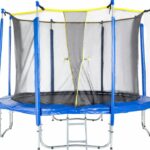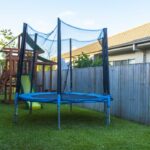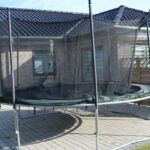A fence around your trampoline will help give you and your family more privacy and protection. However, there aren’t many laws governing whether you’re required to install one around your trampoline. Most states and cities are content to let the industry safety standards and insurance companies monitor how and where you should use your trampoline.
Generally, a trampoline doesn’t legally require a fence. However, this may vary according to where you live and whether the state or local government has laws governing recreational behavior. It’s best to talk to a lawyer or local authorities to see if any trampoline fencing laws exist in your area.
Although it may not be legally essential, a fence around your trampoline will help save you money on medical costs, insurance policy costs, and other related expenses. Let’s take a closer look at whether you need a fence around a trampoline, how much space you need around it, and whether homeowner’s insurance requires a fence. That way, you can take the right measures before you start jumping.
Do You Need a Fence Around a Trampoline?
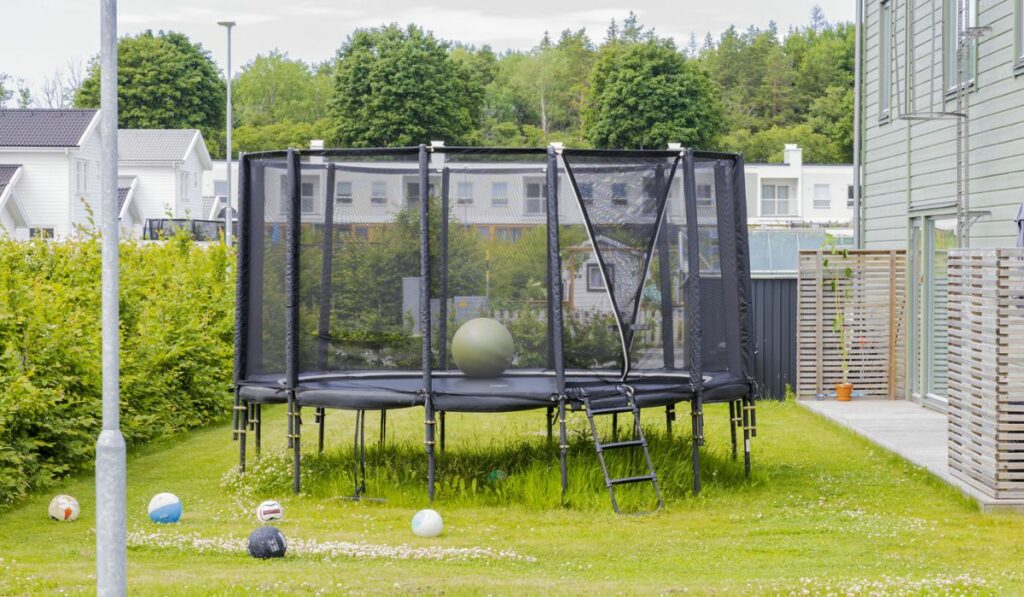
The answer to this question depends on where you live and whether your state or local government has imposed any restrictions on trampoline use. However, in most cases, you won’t need a fence around your trampoline.
Insurance companies are a different matter though. Most insurance companies won’t accept personal injury or liability policies if you don’t have a proper fence around the trampoline.
So, while your state, county, or city may not have any regulations governing how you should use your trampoline, your insurance company might.
You can also install a fence around your trampoline if you want privacy and don’t really want your neighbors to keep an eye on your every move.
How Much Space Do You Need Around a Trampoline?
When people buy a trampoline, they often forget to factor in the space they should leave around the trampoline. This safety margin helps prevent nasty accidents and serious injuries should someone fall off the edge of the trampoline.
When planning the safety margin, you’ll first need to decide whether your trampoline will have a safety net enclosure.
If you’re going to purchase a trampoline without a safety enclosure, then it’s best to leave a margin of at least 8.2 feet on any side. Since you’ll need this space around the entire trampoline, you should add 16.4 feet to your total measurements.
On the other hand, if your trampoline will have a net enclosure, then a margin of only 1.5 feet on each side will be enough. That means you’ll have to add three feet to your total measurements.
Keep in mind that in order to prevent injuries, the safety net enclosure should be 1.5 feet away from any fence or garden wall as well.
So, to summarize, it’s best to plan for the following measurements:
Space Needed for a 10-Foot Trampoline
- Without an enclosure: 26.4 feet
- With an enclosure: 13 feet
Space Needed for a 12-Foot Trampoline
- Without an enclosure: 28.4 feet
- With an enclosure: 15 feet
Space Needed for a 15-Foot Trampoline
- Without an enclosure: 31.4 feet
- With an enclosure: 18 feet
What if Your Trampoline Is Higher Than the Fence?
There aren’t really any county or city laws that stop you from purchasing a trampoline that’s higher than your fence. However, it can be a safety issue, so it’s better to check with your insurance company to see whether your policy covers trampoline-related injuries and accidents.
It’s also important to note that if you reside in a housing authority that has bylaws stating there can’t be anything higher than the fences between yards, then you can’t have a trampoline higher than the fence.
It’s best to check whether your city has any specific neighbor laws as well.
Will Homeowner’s Insurance Require a Fence Around My Trampoline?
Most homeowner’s insurance forms ask whether you own a trampoline. Insurance companies see this piece of equipment as a liability risk, and will probably raise your rates if you haven’t taken the right safety precautions.
The best and safest course of action is to consult with your insurance agent before buying a trampoline to see whether your purchase will have any effect on your total homeowner’s insurance rates.
In most cases, having a trampoline won’t have any effect, as long as you’ve taken the right safety measures. Here are some of the precautions your insurance agent will advise you to take:
- Add a safety net enclosure (on Amazon) around your trampoline. This will help prevent jumpers from falling off the edge of the trampoline and seriously injuring themselves.
- Lock the opening of your trampoline’s netting. Along with preventing little kids from entering the trampoline unsupervised, this will also prevent any neighborhood children from climbing into the trampoline unwatched and without their parent’s permission.
- Anchor your trampoline to the ground with heavy-duty stakes (on Amazon). This will ensure that the trampoline doesn’t fly across the yard and into your neighbor’s car on a particularly windy day.
If you take all the right safety precautions, you should be able to keep your insurance agent happy. If you don’t, your insurance may still cover you, but your company might drop you as a client afterward.
Alternatively, if your agent comes out to check the storm damage on your roof and notices an unsafe trampoline in your backyard, then your rates could shoot up, or you may just end up losing your insurance.
Can My Trampoline Be Next to My Neighbor’s Fence?
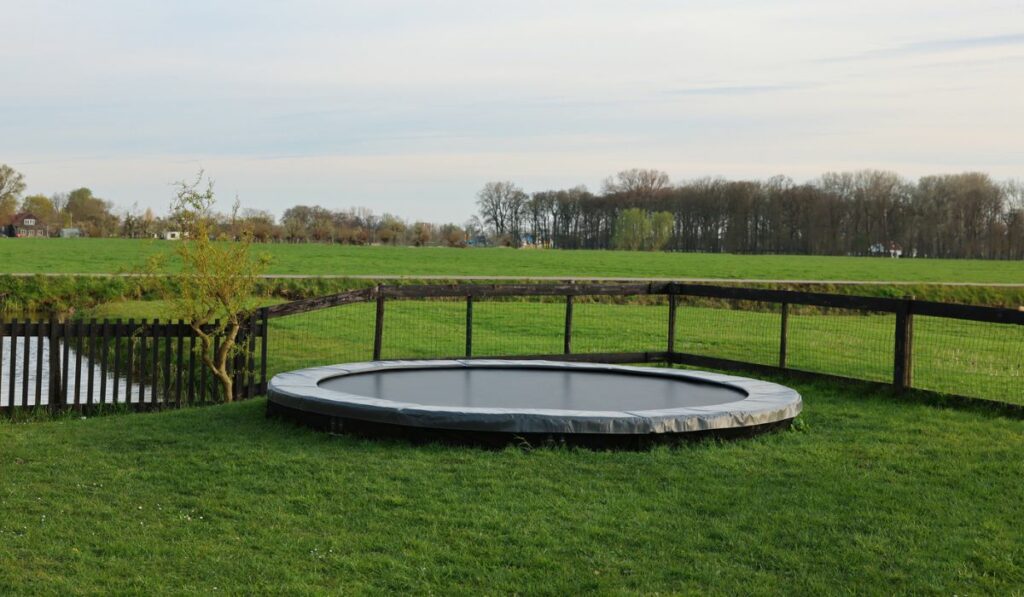
You shouldn’t place your trampoline next to your neighbor’s fence or anywhere where the people jumping on it will be able to see into your neighbor’s homes or gardens, as this can be a serious invasion of privacy.
It also isn’t advisable to keep your trampoline right next to a fence because it can lead to serious injuries. And while liability for trampoline-related injuries is situation-specific, you’ll generally be liable for injuries that occur around or on a trampoline if your negligence is a big part of what caused the injury in the first place.
For this reason, it’s best to have a safety perimeter of nine feet or more around your trampoline. Make sure you also place the trampoline away from the sides of your house, poles, walls, posts, trees, and other such objects that could get in the way or be dangerous in case of a fall.
Can My Neighbor Put Their Trampoline Next to My Fence?
Since you have a right to your privacy, your neighbor should only put their trampoline next to your fence if you’ve given them explicit permission to do so.
If your neighbor leans or hangs things on your fence, or uses it as a makeshift retaining wall, then the supporting posts and panels will have to bear a much heavier burden than they were originally designed to handle.
There are several ways you can handle this situation, but the way you go about it can either spare you a lot of fuss or make your neighbor an enemy for life:
- Talk with a lawyer and check whether there are any laws governing where you should place a trampoline.
- Check your city’s rules and see whether they have any neighbor laws and if a trampoline falls under the guidelines.
In the above two cases, you’ll have your options spelled out for you and your next steps should all be completely legal. However, if you don’t want to go through all the trouble, then you can:
- Talk to your neighbor and politely ask them to move their trampoline.
- Talk to their landlord (if they’re renters) and request that they move the trampoline.
- Consult your insurance agent and see if your insurance policy covers any accidents or injuries that might happen.
- Make your fence higher or install a screen.

